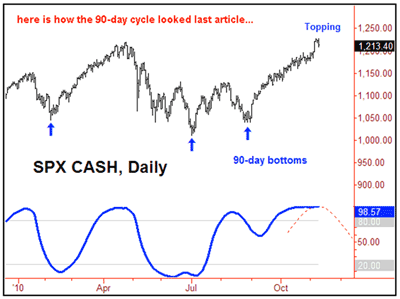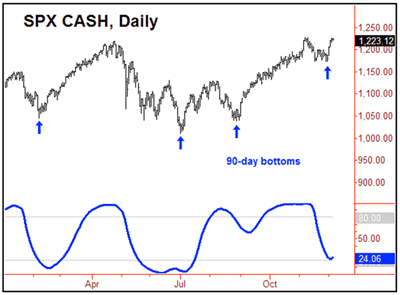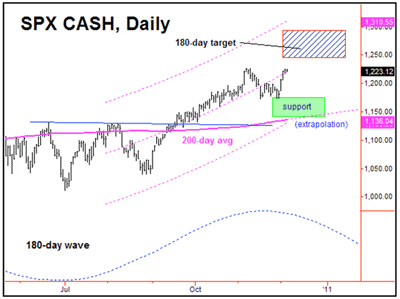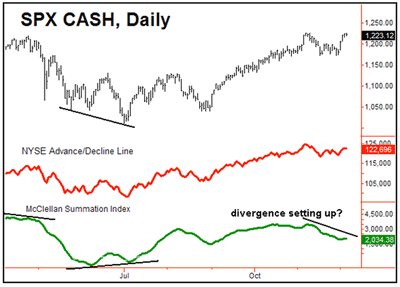By Jim Curry of Market Charts/Market Turns
I recently pointed out that the technical indications favored that the 90-day time cycle was in topping range and was thus due for a short-term peak in the markets. However, that top was not to be made prior to the April high of 1219.80 SPX cash being taken out to the upside. Below is the chart from that article:
Back then, I noted that this 90-day cycle was likely to give way to the largest-percentage correction seen since coming off the late-August bottom. That is, most of the prior corrections had been in the range of about 2.3% off the top, and with that, the coming decline with the 90-day cycle was expected to be greater than this amount.
More specifically, the statistical analysis of the 90-day downward phases in the past had suggested that this correction should be at least seven trading days off the top and would ideally decline 4.4% or better before bottoming out. The actual decline with this component ended up lasting exactly seven days and 4.4%, a direct hit in terms of minimum statistical expectations.
At the time, I pointed out that the correction with the 90-day cycle was only to be short term in nature, as indicators such as the Advance/Decline line had confirmed the action, and thus were suggesting that any short-term decline would end up being followed by a push to higher highs on the following swing up. Here is how this 90-day cycle chart looks at the present time:
Also noted was a still-outstanding upside target from the 180-day cycle to the 1243.16 to 1286.36 region on SPX. In other words, following a correction with the 90-day wave (i.e., 4.4% off the top or better), the following upward phase of this cycle was favored to give way to new highs for the larger swing, and ideally, a move into this 180-day target zone.
NEXT: What SPX Traders Can Expect Now
|pagebreak|What to Expect Now
Right now, the 90-day cycle is deemed to have bottomed at the 1173 level, and thus is pointing higher off the same. Ideally, this means that we are in the upward phase that will top the larger 180-day component, which is now approximately 110 trading days along from it's last bottom, which is at the July 2010 low of 1010.91 SPX cash.
With the above said and noted, the primary focus for mid-term players should be on the 180-day wave, which, as noted above, has a current upside target of 1243.16 to 1286.36 SPX cash, a target that was originally triggered back in October. This range is not only the upside target for this wave, but is also the favored range to complete the current upward phase of this same cycle. Here is what this 180-day component looks like right now:
In terms of time, the larger 180-day wave is favored to top between now and January 2011. Traders should bear in mind that this is a large cycle, and thus, it has a wide average variance of when it could actually form its peak. Even said, the 1243.16 to 1286.36 range is the favored zone for it to top out, and if the SPX does move into this area in the days/weeks ahead, traders should be looking at technical indications to either exit (and/or scale out of) mid-term longs. Alternately, the short side could be attempted, though you should also keep in mind that the larger trend (i.e., with the four-year cycle) is still deemed to be pointing upward for what could be many more months before it peaks!
Technical Action
As noted several times in prior articles, the Advance/Decline line (see chart below) had yet to register a major divergence between itself and price action—something that we would expect to see on or well before the four-year time cycle actually tops. This has been true about 85% of the time in the past history of this larger cyclic component:
With that, the suggestion from the Advance/Decline line had been that higher highs for the larger swing would continue to materialize after shorter-term correction phases. That is, traders who are attempting to call a four-year cycle top before the Advance/Decline line actually diverges are attempting to do something that occurs less than 15% of the time.
Having said and noted the above, there are definite technical warning signs that are currently brewing—at least in regards to the near-term action.
That is, of particular note on the chart above is the action of the McClellan Summation Index, which is shown in green. You can see that this particular indicator is going to be hard-pressed to make new highs for the larger swing, even though price is currently within earshot of doing the same.
This is important, as a divergence in the Summation Index is normally seen at or near cyclic peaks, with many occurring at larger degree tops, such as with the 180-day cycle. In other words, the market is starting to skate on thin ice, at least as far as technicals are concerned. Having said that, it is always possible that normal bullish seasonality could override what the technicals are suggesting.
My basic rule of thumb is that the bigger the divergence in the McClellan Summation Index (and/or the longer that it is present), the larger the following correction will be. Rewind to the July bottom, which saw a good divergence between the Summation Index and price at the time. The following rally was 120 points off that bottom into the August high. There was also a divergence at the April top, one that was not as pronounced in the indicator, though it did last a long period of time. It eventually gave way to the correction into the July 1, 2010 bottom.
For the bigger picture then, we have the Advance/Decline line still in OK shape, though the McClellan Summation Index is looking like it is going to show a good divergence from price, a technical negative if seen as the 180-day target is traded into.
The bottom line with all of the above is this: The SPX should make a move into the 180-day target in the days/weeks ahead. However, the technical indications are starting to suggest internal weakness, which is consistent with what we should expect to see as this larger cycle starts to roll over, ideally occurring some point between now and early-January 2011. Once this cycle does turn down, then once again, we will be set up for the largest percentage correction seen since coming off the late-August low, a correction that is likely to be in the range of 7-10% off the top before bottoming out.
By Jim Curry of Market Charts/Market Turns

























